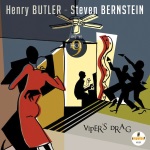Henry Butler is an unquestioned virtuoso, the player who’s pushed the New Orleans piano sound forward the last 30 years. Like James Booker or Art Tatum, he needs no accompaniment to mesmerize an audience. From this viewpoint, Butler’s best albums are arguably his solo performances: Blues and More, Vol. I and PiaNOLA Live.
Butler has recorded several other projects, of course, in duos, trios and quartets. No one can deny that sidemen like Jack De Johnette and Charlie Haden provided stellar moments on Butler’s early recordings. It’s wonderful that he recorded several tracks with Snooks Eaglin. His duet with Kaz Kazanoff, “Tetherball,” on Blues after Sunset is spectacular, a must-hear.
Until now, Henry’s work with larger ensembles (one track on the New Orleans Nightcrawlers’ Funknicity CD and the soundtrack to Robert Altman’s Kansas City) has been erratic. So, Viper’s Drag, his new outing with Steven Bernstein and the Hot 9 is very, very welcome.
New York-based arranger/trumpeter Bernstein is a perfect match for Henry. His charts are, like Henry’s playing, often joyfully raucous, though like Henry he tones it down once in a while for some dolce passages. Most of Bernstein’s arrangements are harmonically straightforward, “inside” in a tasty, interesting way, but he also provides some rather outré prelude/intros on three tunes to showcase his modern sensibilities.
There have been many recent recordings that try to update the classic canon (in this case three Jelly Roll Morton tunes, a Bessie Smith, and a Fats Waller). It’s a tricky thing, and this album pulls it off as well as any. There’s never been a disc exactly like it; think of Ray Charles’ Big Band with more unhinged piano, or perhaps a funkified Earl Hines and His Orchestra and you’re getting warm. It’s Butler’s best collaborative effort.
Special props must go out to drummer Herlin Riley for nailing every groove and harking back to the ragtime era when necessary, and to Bernstein for the inclusion of violinist Charlie Burnham. The fiddle adds sweet, wild-card timbre to these horn-dominated arrangements, and ties the charts to the music’s earliest days as well.
This disc will appeal to listeners who love the whole history of jazz—in other words, the ideal audience. I hope they find these folks.





